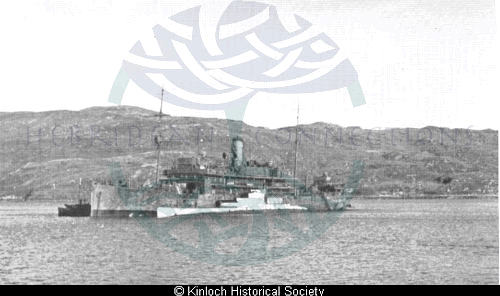38002: The Navy in Keose
In 1942, in response to an Admiralty call for volunteers to be trained for particularly difficult and dangerous operations, a number of men were recruited from the Navy and Royal Marines.
The men, who were required to be good swimmers at the outset, were to be coached to even higher standards as well as being trained to become accomplished divers, using the Davis type equipment. This comprised a rubber suit worn over thick woollen underwear along with lead weighted boots and belt, rubber gloves, underwater mask and mouth-piece connected to the air supply of two oxygen cylinders strapped to their backs.
The hazardous nature of the undertaking became evident early on when diving preliminary suitability testing at Portsmouth, one of the volunteers died in shallow water in broad daylight.
Early in the summer of 1942, a group of around thirty men arrived at Loch Erisort in Lochs, Isle of Lewis, aboard the submarine depot ship "Titania" which anchored between Keose and Garyvard. A landing stage was erected at Keose on the site of the seaweed factory, which, by means of a ladder, gave access to water ranging from twenty feet to thirty feet in depth, ideal for divers training purposes. The Keose base was known to the Navy as Port D.
The divers commenced training on the newly introduced secret equipment known as the Midget submarine or human torpedo. This was a twenty foot long metal cylinder of about twenty five inches diameter and weighing around one and a half tons, driven by a battery powered electric meter. It was designed to carry two men, a pilot and the crewman responsible for underwater operations. It was capable of carrying a warhead containing six hundred pounds of explosives which had to be unbolted from the submarine and attached to its target. A timing device was set to trigger detonation at the required time.
Intensive training continued throughout the summer months of 1942. Continuous diving resulted in noses becoming swolen and raw through being tightly clipped, gums which bled through constant gripping of the mouthpiece while hands became lacerated and sore. The David breathing apparatus was designed to re-absorb exhaled breath so that no tell-tale bubbles would rise to the surface. This increased the danger of asphyxiation and an important feature of the training was in being able to recognise early signs and being able to take prompt remedial action. It is said that around three-quarters of the men lost consciousness on at lease one occasion during the training period and it was a fairly common occurrence for a boat to return with the diver suffering convulsions, or "the bends".
The base at Keose was dismantled on completion of training. The end result of the exercise was that, in September 1943, the midget submarines and their crews were transported to the west coast of Norway in order to attack German warships anchored in the fjords. Their most notable success was in being able to put the great battleship "Tirpitz" out of action for many months, an episode which became the subject of a well-known film. Out of a total of twenty-four engaged in operations in the Norwegian fjords during 1943 and 1944, ten perished and six were taken prisoner after accomplishing their mission. Some of their other successes included the sinking of the "Bolzano", "Barenfels" and "Laksevaag".
All crew members received medals for gallantry and two were awarded the Victoria Cross.
See also the training of submarine crews at Tavay Island, Keose.
Details
- Record Type:
- Story, Report or Tradition
- Date:
- 1942
- Type Of Story Report Tradition:
- Story
- Record Maintained by:
- CECL
